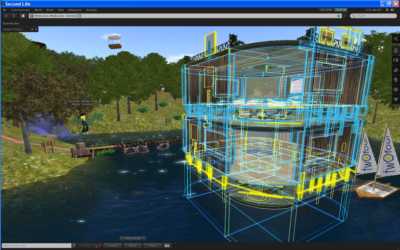Google has been in the news recently. When they sent cars around the UK to take photos for the rather handy Street View project, not only did they make a note of everybody’s wireless network, but, it seems, they stored some of the data being sent across the networks as well. Data like passwords and emails.
Yesterday, something unusual happened in our virtual Media Zoo that brought this to mind. Later this year, we will be running our second major study for the SWIFT project. This will see dozens of students use a virtual genetics lab to add to their learning of practical laboratory skills. Recently, I have been creating a self-directed training area where our participants will be able to go to learn the basics of participating in this virtual world – provided in this case by Second Life.

Self-directed training area for SWIFT
I wanted some sort of path, to guide visitors through a series of tasks, and ended up buying a garden maze for 25 linden Dollars (about 6p here, or 10 US cents). I set that out with a number of information boards, each one describing a particular skill, such as walking, talking to others, putting on a lab coat etc., the idea being to take the visitor through all the skills they will need to participate in the study. Yesterday, I was putting the finishing touches on this induction area, and needed to move the maze half a pace East.
Except I couldn’t edit the maze. On further inspection, it seemed I no longer owned the maze – it now belonged to some random avatar! How strange. How come?
So I bought another maze and “returned” the original to its new owner, then set about figuring out what went wrong. It seems that the maker of this maze set it up rather strangely. Firstly – and this is normal enough – the maze I bought was copy protected: I could give it away or sell it if I wished, but my one copy would be transferred to the new owner and I would lose it. Secondly – and this is the strange part –my maze had been set to “For Sale” with a price of zero dollars. (Usually, the maker leaves this field blank for the new owner to set if they ever wish to resell it). So, my maze was on sale for free without me knowing it, and it seems that some enterprising avatar had snapped it up!
Well, so, who is to blame? Is it a) the maze-maker for leaving their product set to allow anyone to walk off with it, b) myself for not checking every setting on everything I purchase, or c) the other avatar for taking something that was being given away?
Then I remembered Google. They took information that was left lying around because the security wasn’t switched on, on people’s wireless networks – like pasting pages from a personal diary on your garden gate for all to see. So, same question. Who’s at fault? Is it a) the manufacturer of the wifi boxes, b) the owner who’s using the box or c) Google for taking something that was being given away?
I shall be bold here and supply an answer. I don’t think you can blame Google or the visiting avatar. It seems reasonable to me that if something is being given away, and there’s no apparent harm to be done in taking it, and it’s not being taken for any malicious purpose, then by all means take it. (Of course, it has to be legal too, and this is where Google may possibly have a problem).
And I don’t think you can blame the owner. When you buy something, you expect it to just work. Safely.
No, I think it’s down to the manufacturer to think about how their customers will use the object and do their best to make it usable. How many people buy something and want anybody to be able to buy it for free? How many people buy a wifi box and want the whole world to use it?
The same principle needs to apply to our virtual genetics lab. As the “manufacturer”, we have made a lot of effort to ensure that the lab is realistic, effective, and easy to use. November 24th will be the big day, when we let our student volunteers loose in the lab, and find out just how successful we have been.
Paul Rudman, BDRA
Try our new training area yourself; download Second Life and follow this link









